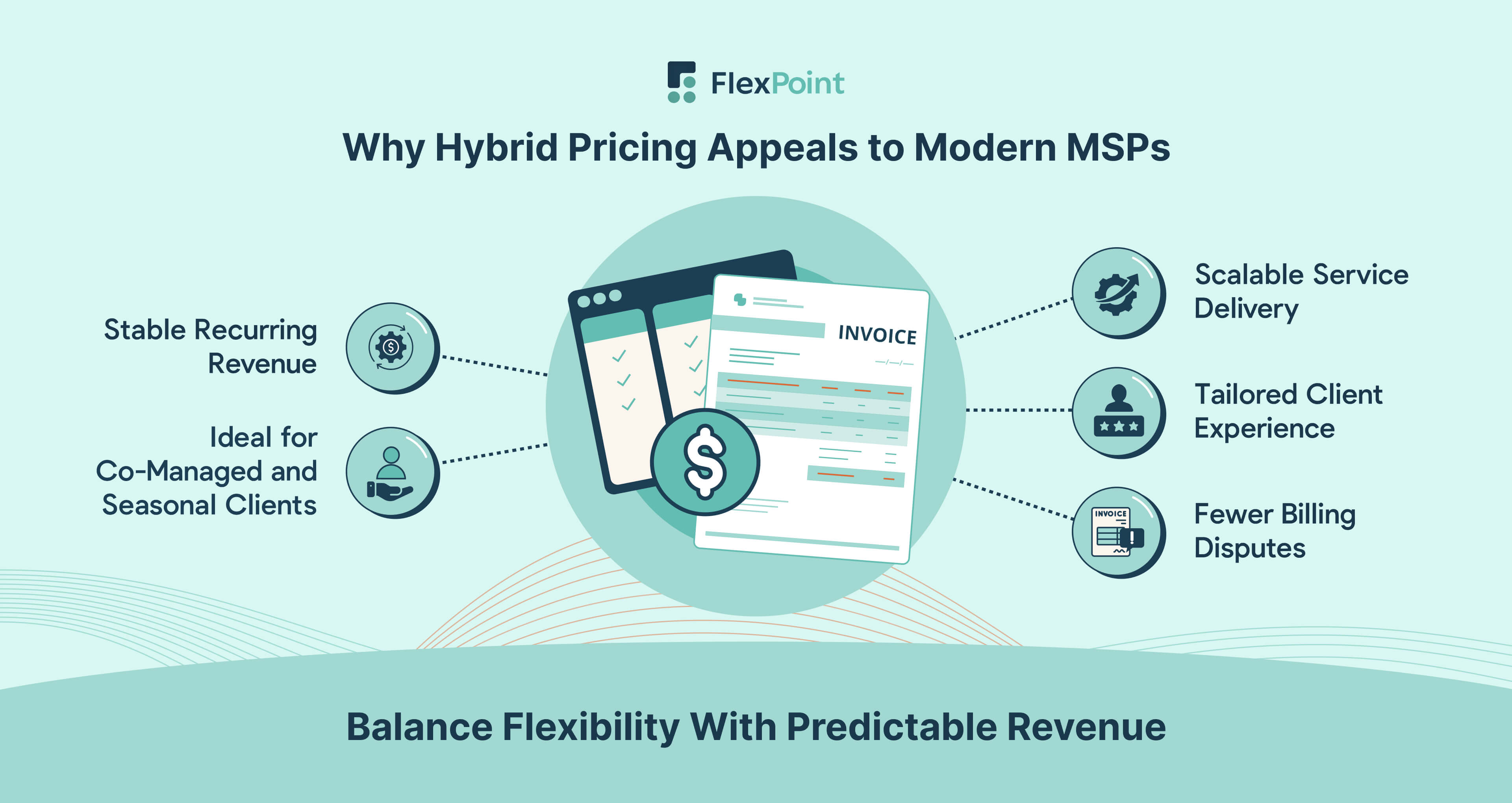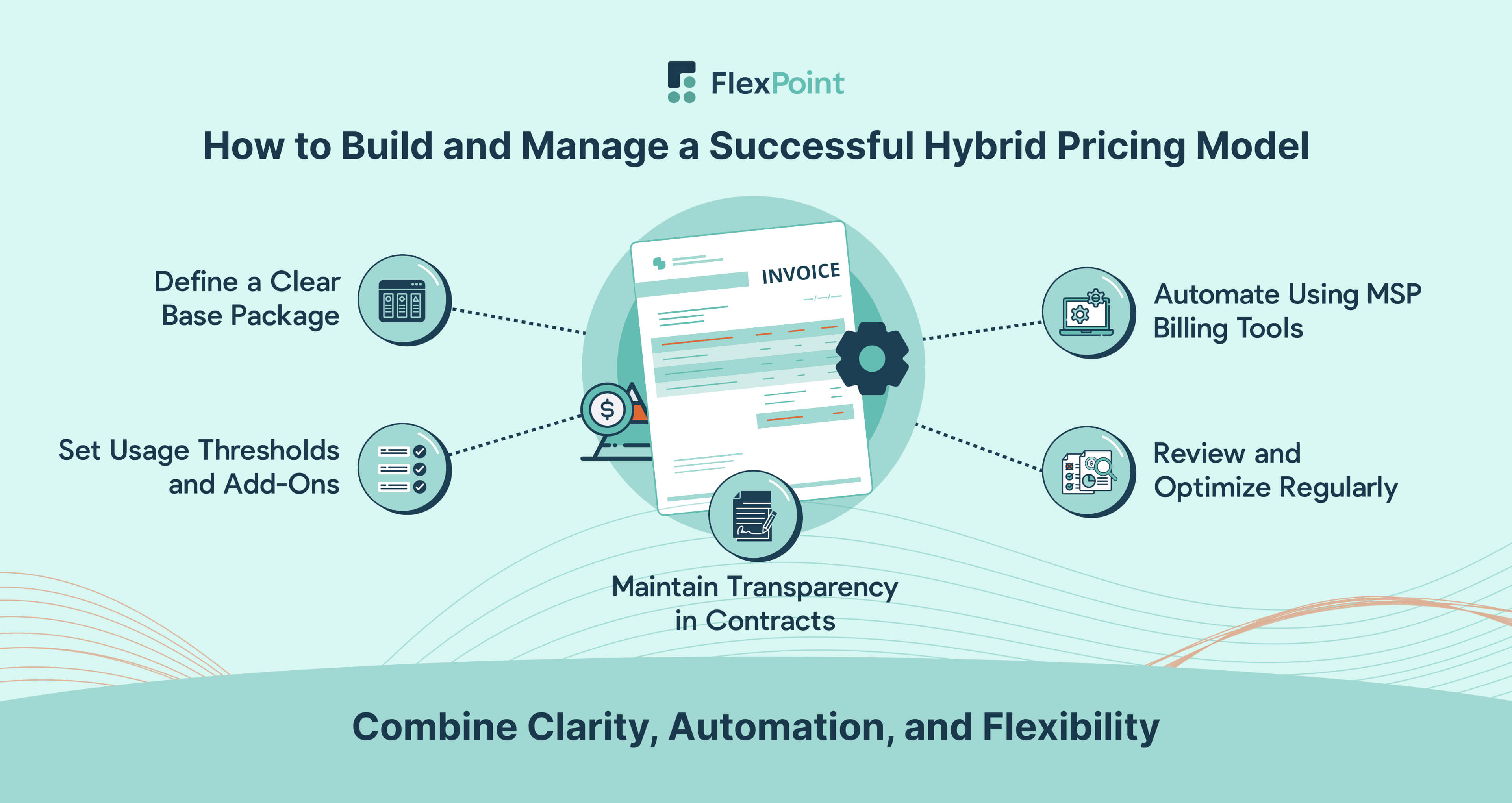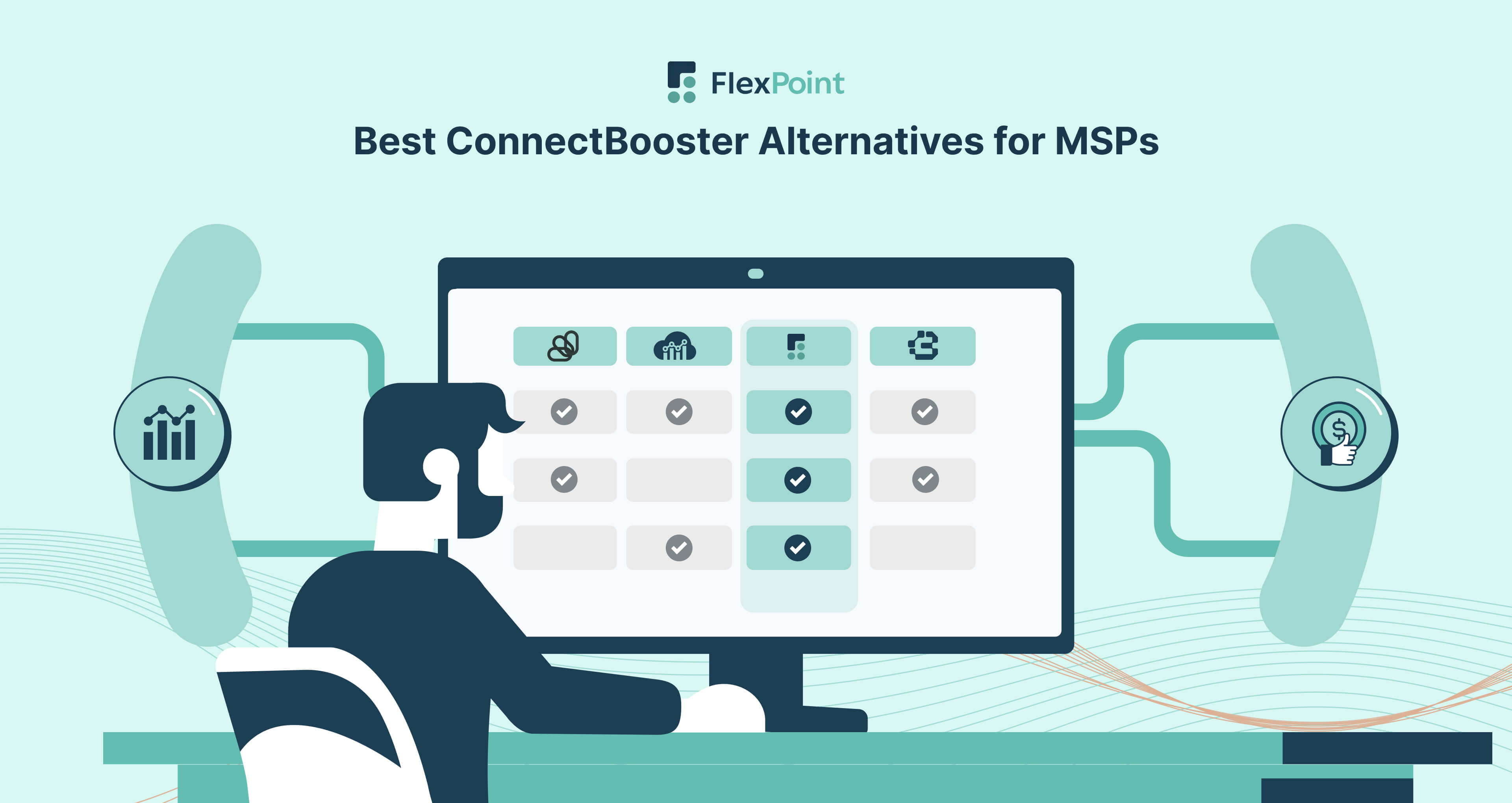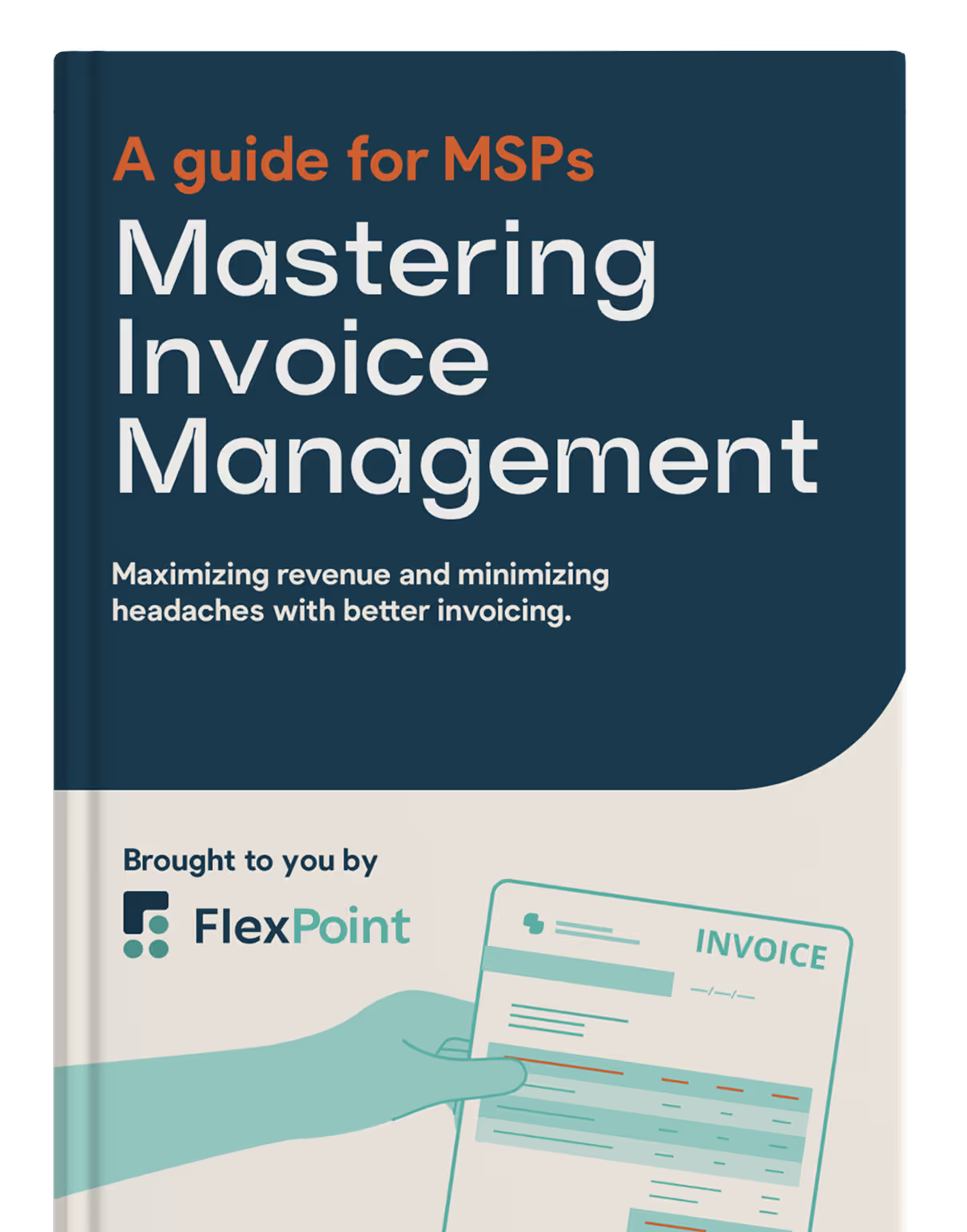MSP Hybrid Pricing Model: Combining Flexibility with Predictable Revenue

According to MSP Success, over 40% of MSPs use a combination of pricing methods. Hybrid pricing models are gaining traction because they adapt to a range of client sizes and service demands.
Although traditional flat-rate billing provides predictable income for Managed Service Providers (MSPs), it can fall short when service usage fluctuates. Conversely, usage-based pricing provides versatility but creates revenue uncertainty.
This leaves MSPs searching for a model that balances financial stability with service adaptability.
Hybrid pricing aims to solve this by combining a fixed monthly fee with variable charges based on actual usage. This approach enables MSPs to lock in a baseline of recurring revenue while allowing clients to scale services as needed.
In this article, we will define the hybrid model, highlight its benefits, and outline common structures MSPs can adopt.
We will also cover strategies for implementation, how to maintain transparency with clients, and the role of automation. Finally, we will discuss how using a MSP-specific billing automation software simplifies hybrid billing by combining PSA integrations, usage tracking, and automated invoicing into one streamlined platform.
{{toc}}
What Is the MSP Hybrid Pricing Model?
Hybrid pricing combines a flat recurring charge with variable fees linked to usage. This might include per-device billing, per-user charges, hourly rates for out-of-scope work, or premium service add-ons.
For example, an MSP may charge $2,000 per month to cover up to 50 devices and then add a $40 charge for each additional device. The base rate guarantees stable income, while the usage-based component ensures clients only pay more when their needs increase.
Compared to fixed-rate or fully usage-based models, hybrid pricing offers more flexibility without sacrificing financial consistency. It aligns pricing with real service consumption.
MSPs typically tailor the base package to cover core services such as monitoring, patch management, and helpdesk support. The variable charges apply when clients exceed agreed limits or request optional services.
This pricing approach is especially useful for clients with seasonal fluctuations, evolving service needs, or inconsistent device counts. It creates a model that can scale with the client while helping the MSP maintain profitability.
{{ebook-cta}}
Why Hybrid Pricing Appeals to Modern MSPs

Hybrid pricing provides distinctive advantages that make it an ideal solution for MSPs trying to balance client flexibility with predictable income.
The advantages of the hybrid pricing model include:
- Stable recurring revenue: The base monthly fee secures reliable income, which helps with budgeting, hiring, and resource planning. Unlike usage-only billing, MSPs don’t have to guess how much revenue they’ll earn each month.
- Scalable service delivery: Variable charges support client growth. As clients add users, devices, or request more services, MSP revenue increases proportionally. This creates natural upsell opportunities without renegotiating contracts.
- Tailored client experience: Hybrid models let clients control what they pay for. A client may stick with the base plan or choose to add premium services. This flexibility can contribute to higher client satisfaction and retention.
- Ideal for co-managed IT and seasonal clients: Hybrid pricing fits co-managed setups where internal IT teams need backup on demand. It’s also suited for clients with seasonal swings in support needs or staffing levels.
- Fewer billing disputes: When done transparently, clients understand what’s included and what costs extra. A clear agreement and detailed invoicing reduce confusion and support a long-term relationship.
As hybrid models become more common, tools that support flexible billing can help MSPs scale without complexity. Hybrid pricing reflects how clients want to buy and how MSPs want to grow.
3 Common Hybrid Pricing Structures MSPs Use
Hybrid pricing doesn’t follow a single formula. Most MSPs use a combination of base rates and usage-based charges tailored to their services and client profiles.
The structure can vary depending on:
- The complexity of the client’s environment
- How often their needs change
- What services fall inside or outside of the core agreement
Below are three commonly used hybrid pricing setups, along with a sample invoice of each structure:
1. Base Plan + Usage Tiers
This model includes a fixed monthly fee that covers service for a specific number of users, devices, or other units. Any usage beyond that limit is billed at a set per-unit rate or in pre-defined tiers.
For example, the base rate may include support for 50 users, with a $60 charge for each additional user.
Example:
- Base Plan (up to 50 users): $2,500
- Additional Users (7 @ $60 each): $420
Total: $2,920
This approach provides predictability while allowing for scalable growth. It works well for clients whose teams fluctuate or whose device counts increase during onboarding or seasonal expansion.
2. Bundled Services + Hourly Support
Here, the MSP offers a standard set of services for a flat fee, such as patch management, monitoring, and a remote help desk. Anything outside the defined scope, such as project-based work, after-hours support, or onsite visits, is billed hourly.
Example:
- Monthly Managed Services Bundle: $3,000
- Onsite Project Support (6 hours @ $125/hour): $750
- After-Hours Emergency (2 hours @ $150/hour): $300
Total: $4,050
This structure is ideal for MSPs serving co-managed environments or clients with occasional advanced support needs. It also ensures that time-intensive services are adequately compensated, without inflating the base rate for all clients.
3. Flat Rate + Premium Add-Ons
The base package includes foundational services. Clients can then choose from a catalog of optional services, including advanced cybersecurity, compliance monitoring, or vCIO consulting, billed at additional flat or usage-based rates.
This setup makes it easy for MSPs to upsell while letting clients customize their plan.
Example:
- Standard MSP Services: $2,200
- Add-On: Advanced Email Security: $300
- Add-On: Quarterly vCIO Services: $500
Total: $3,000
These structures aren’t mutually exclusive. Many MSPs combine elements to meet the specific needs of each client.
To prevent errors and simplify the process, MSPs often use automation platforms such as FlexPoint’s MSP Billing Software. Billing automation handles service tracking, calculates usage-based charges, and produces clear, timely invoices.
How to Build and Manage a Successful Hybrid Pricing Model

A successful hybrid pricing model begins with a well-defined base package.
Clearly outline what’s included, such as monitoring, patching, or remote support, and set usage thresholds tied to devices, users, hours, or ticket volume. This foundation keeps billing consistent and makes it easier to scale services as needed.
Next, define how you’ll handle overages and add-on services.
Choose metrics that are easy to track and directly tied to your effort. Per-device, per-user, per-gigabyte, and hourly rates are all commonly used. Keep pricing structures simple so clients can easily understand when and why charges change.
Transparency is critical. Contracts should spell out exactly what the client gets for their base fee and what triggers additional charges. If there’s a cap, such as 100 users, make it clear. Set and communicate overage rates in advance.
Invoices should follow the same logic. Use line-item detail to show exactly what’s being billed. For example: "Extra support hours: 3 @ $100 = $300"
This level of clarity reduces confusion, speeds up payment, and builds trust.
To manage hybrid pricing efficiently, automation is key. A billing platform, such as FlexPoint, integrates with your PSA (e.g., ConnectWise, AutoTask, SuperOps, HaloPSA) and Accounting tools (e.g., QuickBooks Online, QuickBooks Desktop, Xero) to pull in usage data, calculate charges, and apply pricing rules automatically. It supports thresholds, tier changes, and detailed invoices—without manual effort.
As your client base grows, revisit pricing regularly. Look at usage data to see who consistently exceeds limits or underutilizes services. Adjust packages accordingly.
Periodic client feedback can also uncover opportunities to fine-tune your pricing or expand service offerings.
When supported by automation and proactive communication, hybrid pricing becomes manageable and profitable. It allows MSPs to offer flexible billing while still protecting margins and delivering consistent value.
Conclusion: Finding the Balance Between Flexibility and Predictability
Hybrid pricing helps MSPs achieve two things that often seem at odds: stable revenue and client flexibility.
By combining a fixed base fee with usage-based billing, MSPs create a structure that meets their financial goals while adapting to how clients consume services.
Clients don’t want surprises, but they also don’t want to overpay. Hybrid pricing offers a middle ground. It covers baseline services while letting them pay extra only when necessary. This builds trust and increases satisfaction.
From the MSP’s side, a well-designed hybrid model protects margins and creates opportunities for growth. As clients scale, add staff, or need more support, the billing grows accordingly. That growth aligns with value delivered.
Still, success depends on structure and systems. A vague hybrid plan can backfire. It leads to confusion, billing disputes, or lost revenue. That’s why defining services, setting limits, and communicating clearly is critical.
FlexPoint removes the billing and payment friction for MSPs. The platform integrates with your PSA tools, tracks usage, applies rates, and generates detailed invoices. Alternatively, if you choose to send invoices from your PSA or accounting software, the payment data automatically syncs bi-directionally with FlexPoint. You don’t need to chase down metrics or worry about inconsistent billing.
With FlexPoint, MSPs can:
- Set up automated hybrid billing rules
- Track client usage in real-time
- Send automated payment reminders to reduce late payments
- Provide a branded client payment portal for billing transparency
- Monitor margins and adjust thresholds
All of this makes hybrid pricing easier to execute and scale.
As client needs evolve, a flexible billing model is no longer optional. Hybrid pricing allows MSPs to stay relevant, competitive, and profitable.
Whether you're adding new service tiers, onboarding seasonal clients, or expanding co-managed IT offerings, the hybrid model offers the balance you need. When combined with the right technology, it’s a powerful way to grow your MSP business with clarity and confidence.
Considering a hybrid pricing model for your MSP?
FlexPoint makes it easy to automate billing for fixed and variable services.
Schedule a demo to see how FlexPoint supports flexible, scalable billing structures for modern MSPs.
{{demo-cta}}
Additional FAQs: MSP Hybrid Pricing
{{faq-section}}











